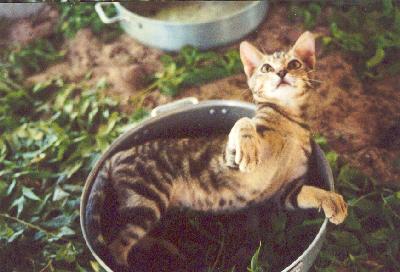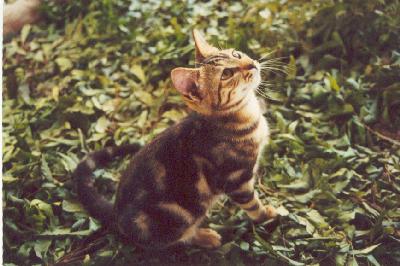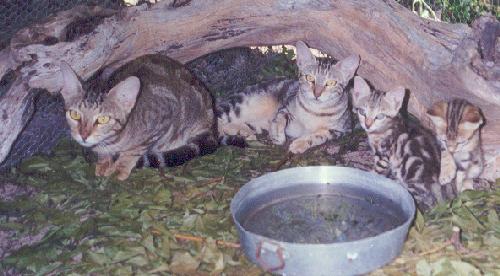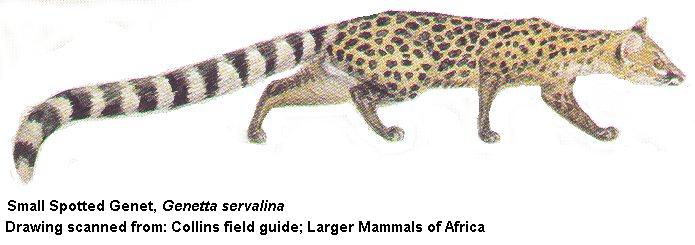Sokokes in Kenya
|
All photos are taken by Jeannie Knocker (the woman with the sokokes in Kenya), if nothing else is mentioned. The quality of the photos vary somewhat and some are of rather poor quality as far as true colours goes, but they should still give you an idea about the cats. Anita H. Engebakken has the orginal paper photos and has scanned the photos with premition from Jeannie Knocker.
|
 Late
fall 2001 we (sokoke breeders) got an exciting and pleasant message
saying it probably were more sokokes in Kenya! If this really were true
it would be a dream come true. For years there had been searchings for
sokokes in Kenya with no luck. The sokoke as a breed in Europe and
Americas started to show clear signs of inbreeding depression and new
blood was crutial for the survival of the breed. As new Kenyan
"real" sokokes seemed to be impossible to get, outcorssings
with other breeds or domestic cats from Kenya was beeing discussed from
time to time, but nobody really wanted to do this. Even if the sceptism
was rather big when the message first arrived about new sokokes in
Kenya, a few embraced the idea imediatly and started looking into the
matter. Late
fall 2001 we (sokoke breeders) got an exciting and pleasant message
saying it probably were more sokokes in Kenya! If this really were true
it would be a dream come true. For years there had been searchings for
sokokes in Kenya with no luck. The sokoke as a breed in Europe and
Americas started to show clear signs of inbreeding depression and new
blood was crutial for the survival of the breed. As new Kenyan
"real" sokokes seemed to be impossible to get, outcorssings
with other breeds or domestic cats from Kenya was beeing discussed from
time to time, but nobody really wanted to do this. Even if the sceptism
was rather big when the message first arrived about new sokokes in
Kenya, a few embraced the idea imediatly and started looking into the
matter.When it was confirmed by photos that this really WERE sokokes, the joy was great and so were the relieve with those who had worked hardest to achieve this goal. We got to know about the cats because Will Knocker wrote to Helle Laruridsen and said his mother had sokokes on her farm in Kenya. The entire sokoke breed own the both a big thank you for taking the initial steps starting to email each other and finding out this was EXACTLY what we've been looking for! The new Kenyan Sokokes was gathered and held in one place because a filmcrew wanted to make a film about the cats in Kenya based on the book "The cats of Lamu". They had allready filmed the cats on Lamu. These cats look a lot like Sokokes in conformation, but have totally different colours and usually with white. The filmcrew asked Jeannie Knocker (Will's mother) if she could look after the cats for them, if they paid and put up the cat enclosure. She accepted to do this and the adventure with the new Sokokes began. |
 The
film ended in nothing, and Jeannie was sitting in Kenya with 8 Sokokes.
She began to breed these cats and found them to breed true when it comes
to conformation and pattern. This was an important step in the decision
wether these really was Sokokes or not. At the time we got in contact
with Jeannie she had allready had 2 litters with a total of 5 kittens. The
film ended in nothing, and Jeannie was sitting in Kenya with 8 Sokokes.
She began to breed these cats and found them to breed true when it comes
to conformation and pattern. This was an important step in the decision
wether these really was Sokokes or not. At the time we got in contact
with Jeannie she had allready had 2 litters with a total of 5 kittens.As soon as we had made contact with Jeannie, gotten a bit more information about her cats and photos of these, plans were made on how these cats could and should be included to the Sokoke breeding. 2 breeders imediatly decided to get some cats out of Kenya, Edith Peulicke and Robert Liljeson, S*Kasafari in Sweden and Anita H. Engebakken, Kimburu in Norway. Because our goverments demand a 6 months quarantine to get the cats from Kenya and into Sweden and Norway, we needed a person in Denmark to serve as the quarantine station. Helle Lauridsen, af Kibutata, graciously took on this task and is as such a very important person in forfulling the dream of new blood to our Sokokes. |
 It
turned out it fit Edith and Robert to put their vaccation to Kenya in
2002. Allready in August 2002 the two first Sokokes from Kenya arrived
in Denmark. The male Genet and the female Mara. They left for Sweden in
February 2003. It
turned out it fit Edith and Robert to put their vaccation to Kenya in
2002. Allready in August 2002 the two first Sokokes from Kenya arrived
in Denmark. The male Genet and the female Mara. They left for Sweden in
February 2003.
Next "batch" of Kenyan Sokokes will arrive in Denmark in the spring 2004. 2 females, Malaika and Kadzo, and 1 male, Miwani, will arrive in Denmark and then move on to Norway 6 months later. The 5 new Sokokes are not related as far as we know, and since they are found in different sections of the Sokoke Area there is a good chance this holds true. If so these 5 Sokokes will ad more new genetic diversity to the Sokoke breed than the entire fundation the Sokokes stand on today. Some cats are also imported into USA. 2 are full siblings to Kadzo, 1 is a son of Genet and a female not represented in Europe (Kwanza) and the last is unrelated to our "European" Kenyan Sokokes. |
With the correnspondace with Jeannie I have also been able to shed some new light about the origin of the Sokokes and corrected some "mistakes" from the past. One of the most important "mistakes" are about the Giriama tribe's relationship with these cats. The old information says that they call Sokokes "Kadzonzo" that means "look like tree bark" and that they ate Sokokes in the old days. Jeannie has informed me that it isn't so. The Giriama tribe calls the Sokokes Kadzonzo, but it has another meaning that what we were first told. Kadzonzo consits of two words from the Giriama tribe's own language. "kadzo" which means "beautiful" and "nzo" which means "come". The meaning of Kadzonzo is close to "come beautiful one". |
 The
Giriama people also calls genets Kadzonzo, and it's THESE they have
eaten in the old days, and still eat today. It seems like the Giriama
tribe does not separate between these two species in words, but
they only eat the genets. A genet is an animal that looks somewhat like
a mixture of a weasel and a cat, and has absolutely nothing to do with
Sokokes (or cats). The
Giriama people also calls genets Kadzonzo, and it's THESE they have
eaten in the old days, and still eat today. It seems like the Giriama
tribe does not separate between these two species in words, but
they only eat the genets. A genet is an animal that looks somewhat like
a mixture of a weasel and a cat, and has absolutely nothing to do with
Sokokes (or cats).
Below is a drawing of a "small spotted genet, Genetta servalina" This is a species of genet that excists in Kenya, possibly has the Giriama tribe eaten genets of this species. There are more species of genets, but all look more or less like eachother. |
|
|
 This
was as small introduction to how we got the possibillty to introduce
more new blood from Kenya to our Sokokes. What the end result of this
will be, we don't know yet. From all we know it has to be a major
positive event for the Sokoke as a breed and will be of the greatest
help to make sure these beautiful, but rare, breed of cats survive as a
pure breed. This
was as small introduction to how we got the possibillty to introduce
more new blood from Kenya to our Sokokes. What the end result of this
will be, we don't know yet. From all we know it has to be a major
positive event for the Sokoke as a breed and will be of the greatest
help to make sure these beautiful, but rare, breed of cats survive as a
pure breed.To those of you who may be conserned that we endanger or extinct the Sokokes from their natural area in Kenya, this will not happen. We have taken so few cats into the Sokoke breeding program that there are bound to be almost as many Sokokes in Kenya as there are allways been. If not the destruction of the Arabuko Sokoke forest has destroyed the life of the feral Sokoke population. Keep in mind also that these are only feral cats, and not a wild cat. |
|
This is a map showing where the first 8 Sokokes of the new ones were found in Kenya. 3 of the 4 newer findings (later on even more) are found further towards Malindi that this map shows. The map is made by Anita H. Engebakken after a scetch by Jeannie Knocker. |

